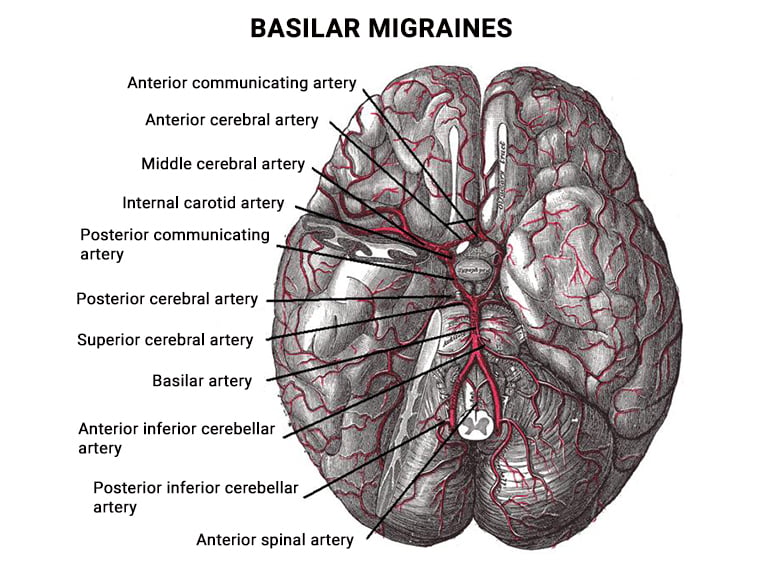There are several migraine headaches, but basilar migraines are characterized by the aura phase, which affects your visual field. It is possibly caused by poor blood flow to your brain from your brainstem. This migraine attacks both sides of your head, making it particularly disabling. To avoid the pain of basilar migraines, put your trust in Dr. Amr Hosny at the Advanced Headache Center. With eight offices across Midtown Manhattan and Bergen County, New Jersey, this practice specializes in diagnosing and treating all kinds of migraines, including basilar migraines. Call today for an appointment.
What Should I Know About Basilar Migraines?
Migraines are debilitating headaches that occur because of faulty nerve signals in your brain. Basilar migraines start at the brainstem and can affect both sides of your brain. These headaches can attack anyone at any age, but receiving an early diagnosis makes it easier to alleviate the symptoms. Doctors link basilar migraines to poor blood flow to the brain.
These migraines can last anywhere from four to 72 hours, although they go through stages. This is a different migraine than a hemiplegic or optical migraine, although they share similar symptoms. With a basilar migraine, you commonly experience visual symptoms that not only distort your vision but may make you see things that aren’t there. These aura phenomena are warning signs before the headache attack.
Migraines can be life-altering episodes because over-the-counter painkillers can’t tame them, and they may cause you to withdraw from your normal activities. With an early diagnosis from a migraine specialist like Dr. Amr Hosny, you get an effective individualized treatment plan to control the pain and avoid future attacks. Dr. Hosny and his team at the Advanced Headache Center in New York City and northern New Jersey use the latest medical technology to diagnose and treat basilar migraines.

Is a Basilar Migraine Known by Another Name?
Basilar migraines are rare, but they’ve been studied for years. You may find references to this condition under a variety of different names. It was originally called a basilar migraine because it was thought the basilar artery caused it. But this isn’t true, so the name has changed a few times.
You may find references to other terms, including:
- Migraine with brainstem aura (MBA)
- Basilar-type migraine
- Basilar artery migraine
- Brainstem migraine
- Vertebrobasilar migraine
- Basilar-type migraine
- Bickerstaff’s syndrome
All these terms refer to the same migraine headache. Find doctors who understand this at a migraine center near you. They leverage the latest technology to offer a multimodal treatment approach for the best outcomes.
What Are the Probable Causes of Basilar Migraines?
The exact causes of migraines are still unclear, despite all the research. Studies of basilar migraines, in particular, are ongoing. While the causes can’t be nailed down, the research has uncovered several risk factors that may trigger migraines with a brainstem aura.
These include:
- Use of alcohol
- Caffeine consumption
- External factors, such as weather changes, disruptive sounds, or sudden changes in light
- Insomnia
- Strenuous physical activity
- Stress
- Certain medications
- Genetics or a family history of migraines
- Hunger from missing meals
- Female hormone changes
- Certain foods, such as chocolate, sandwich meat, bacon, and processed foods
During diagnosis, Dr. Hosny tries to identify which of these factors trigger your headache. Everyone reacts differently, and what spurs your specific headache provides clues to effective treatment. After diagnosis, your migraine specialist develops an individual treatment plan to eliminate your pain and prevent future headaches.
My migraines were even causing trouble while I was at work. I went to see Dr. Hosny and he is now controlling them in a very comfortable way. At my last appointment, he told me that I just need one injection every 2-3 months, so I am very relieved. I feel lucky I found him!
What Are the Symptoms of Basilar Migraine Headaches?
If you have a recurrent headache that affects the quality of your life, consult with a migraine expert. Basilar migraines produce multiple symptoms besides pain. And many signs precede an actual migraine attack. The aura stage of a basilar migraine doesn’t last more than 30 minutes, but you can get quick medical attention when you learn to recognize the symptoms.
The aura symptoms include:
- Vertigo
- Speaking and hearing difficulties
- Feeling unsteady or suddenly uncoordinated
- A loss of muscle control
- Abnormal flashes of lights
- Numbness in your face, hands, or head
- Tinnitus or ringing in your ears
- Unexplained fatigue and exhaustion
- Double vision, blind spots, or graying vision
- Cold hands and feet
- Cognitive confusion
- Nausea and vomiting
- Loss of consciousness
If you’ve experienced more than one of these symptoms before the onset of your headache, you likely have a basilar migraine. Dr. Hosny, a Harvard-trained headache specialist, can get to the bottom of your headache pain to diagnose the issue and treat it. At any of the eight locations of the Advanced Headache Center, you can receive specialized attention for migraines with a brainstem aura.
Is There a Treatment for Basilar Migraines?
If you’ve suffered multiple migraine attacks and auras, you need a migraine expert to confirm a diagnosis of basilar migraine. Basilar migraine treatment may include not just one but a combination of therapies. Dr. Hosny may recommend:
- A combination of migraine medications in rational polypharmacy approach
- Medications such as non-steroidal anti-inflammatory drugs (NSAIDs) and antiemetic medications for nausea and vomiting
- Lifestyle changes to avoid the known triggers
- Preventative medication such as lamotrigine, verapamil or topiramate
Visit any of the eight locations of the Advanced Headache Center — in New York City at Union Square, Midtown, and the Financial District, and across the river in Paramus, Riverdale, Englewood Cliffs, and Cranford, NJ. Dr. Hosny and the team use state-of-the-art technology to reach an accurate diagnosis and determine the most effective treatment for the symptoms of your basilar migraines. Contact the headache specialists to enjoy lasting migraine relief.

Dr. Hosny is an Ivy League Trained, UCNS-accredited, board-certified headache specialist who offers the latest preventive and abortive treatments to provide safe and effective head pain relief. As an active member of prominent organizations and professional societies that advance headache science, education, and management, such as the National Headache Foundation, Dr. Hosny specializes in diagnosing and treating a wide range of head pain disorders, including tension headaches, migraines, and cluster headaches, to name a few.
Dr. Hosny's reputation for enhancing headache care quality through the use of the most effective and technologically advanced treatment options for persistent primary and secondary chronic headaches has been acknowledged by Castle Connolly and Healthgrades, where he has received over 200 positive reviews. Dr. Hosny is also recognized as a distinguished New York City physician and headache specialist by New York Magazine.
More about Dr. HosnyNew York, NY 10003
(646) 763-2222




